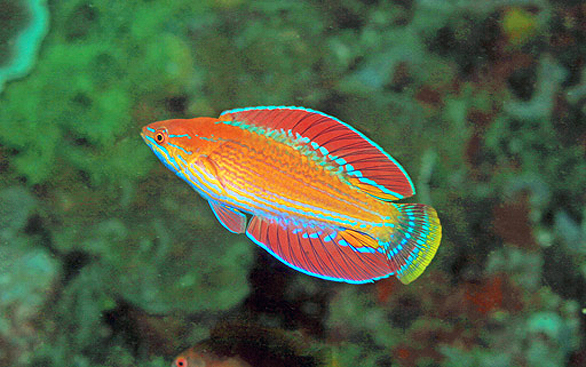
Paracheilinus rennyae, endemic in the waters of Komodo National Park. Image by Mark Erdmann, Conservation International.
Although best-known as the home of the world’s largest living lizard, Komodo National Park in the Lesser Sunda Islands of Indonesia is also a noteworthy dive destination that attracts biodiversity researchers doing marine species surveys in the Coral Triangle.
One of those scientists, Dr. Mark Erdmann of Conservation International, has found and described a gloriously pigmented new species of Flasher Wrasse, Paracheilinus rennyae.
The fish, distinguished by its rounded dorsal, anal, and caudal fins, is named in honor of Renny Kurnia Hadiaty from the Indonesian Institute of Sciences (LIPI) and in recognition of her scientific contributions to Indonesian fish taxonomy.
Erdmann, Conservation International’s (CI) senior adviser to the Indonesian Marine Program, says that Renny’s Flasher Wrasse is endemic to East Nusa Tenggara, the province in southeastern Indonesia where Komodo Island National Park is located. Conservationists are hopeful that such discoveries will help protect such areas from development.
“East Nusa Tenggara has more endemic species of flasher wrasses, which will hopefully encourage more tourists to come to Indonesia, since they can only see the endemic species here, including the new flasher wrasse,” Erdmann said on Wednesday.
According to Erdmann, the first picture of a new, unknown wrasse was taken by a diver in Nusa Tenggara Timor (NTT) in 2010.
“When the diver showed us the picture, we assumed it was a new species of flasher wrasse. Scientists from Udayana University [in Bali] later confirmed the species was genetically distinct from other flasher wrasse species,” he said.
Following collaboration between scientists from Udayana University, Papua State University in Manokwari, Diponegoro University in Semarang, University of California, Los Angeles (UCLA) and Conservation International Indonesia, a description of the new species by Dr. Gerald Allen, Dr. Erdmann, and Ni Luh Astria Yusmalinda was published in the year-end edition of aqua, International Journal of Ichthyology.
Popular among reef aquarium keepers and divers alike, flasher wrasses are known for their gaudy mating displays, in which the males flare their fins and “flash” electric-blue colors to attract females and initiate spawning events.
Paracheilinus rennyae is genetically distinct from other known flasher wrasses in the Coral Triangle, with its closest relative being Paracheilinus angulatus from East Kalimantan, Brunei, Sabah and the southern Philippines.
“The Maritime Affairs and Fisheries Ministry is increasingly aware of the need to generate more revenue from underwater tourism due to the country’s marine biodiversity, rather than solely depending on fishing,” Erdmann said. “But we haven’t yet calculated the value of these endemic flasher wrasse to NTT’s tourism,” he continued.
Sources
Image, Northern tip of Komodo Island: Jon Hanson/Wikipedia/Creative Commons
Abstract
Gerald R. Allen, Mark V. Erdmann and Ni Luh Astria Yusmalinda: Paracheilinus rennyae, a new species of flasherwrasse (Perciformes: Labridae) from southern Indonesia, aqua, Volume 19, Issue 4 – 25 October 2013, pp. 193-206.
The Indo-Pacific labrid fish Paracheilinus rennyae is described from four male specimens, 52.2-60.4 mm SL, collected in 15-21 m depth off southwestern Flores Island in the Lesser Sunda island chain of Indonesia. It is distinguished from most congeners by the lack of filamentous extensions of the dorsal fin rays in males and a rounded caudal fin margin, a combination of features shared only by P. octotaenia (Red Sea). It differs from the Red Sea species in having 13-14 rakers (vs. 16-18) on the first gill arch and several colour pattern differences. Genetic analysis (CO1) indicates it is closely related to P. angulatus from the Philippines and northern Borneo (Brunei, Sabah, and Kalimantan), but the two species exhibit marked differences in the shape of the median fins.






Trackbacks/Pingbacks